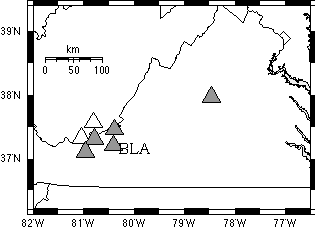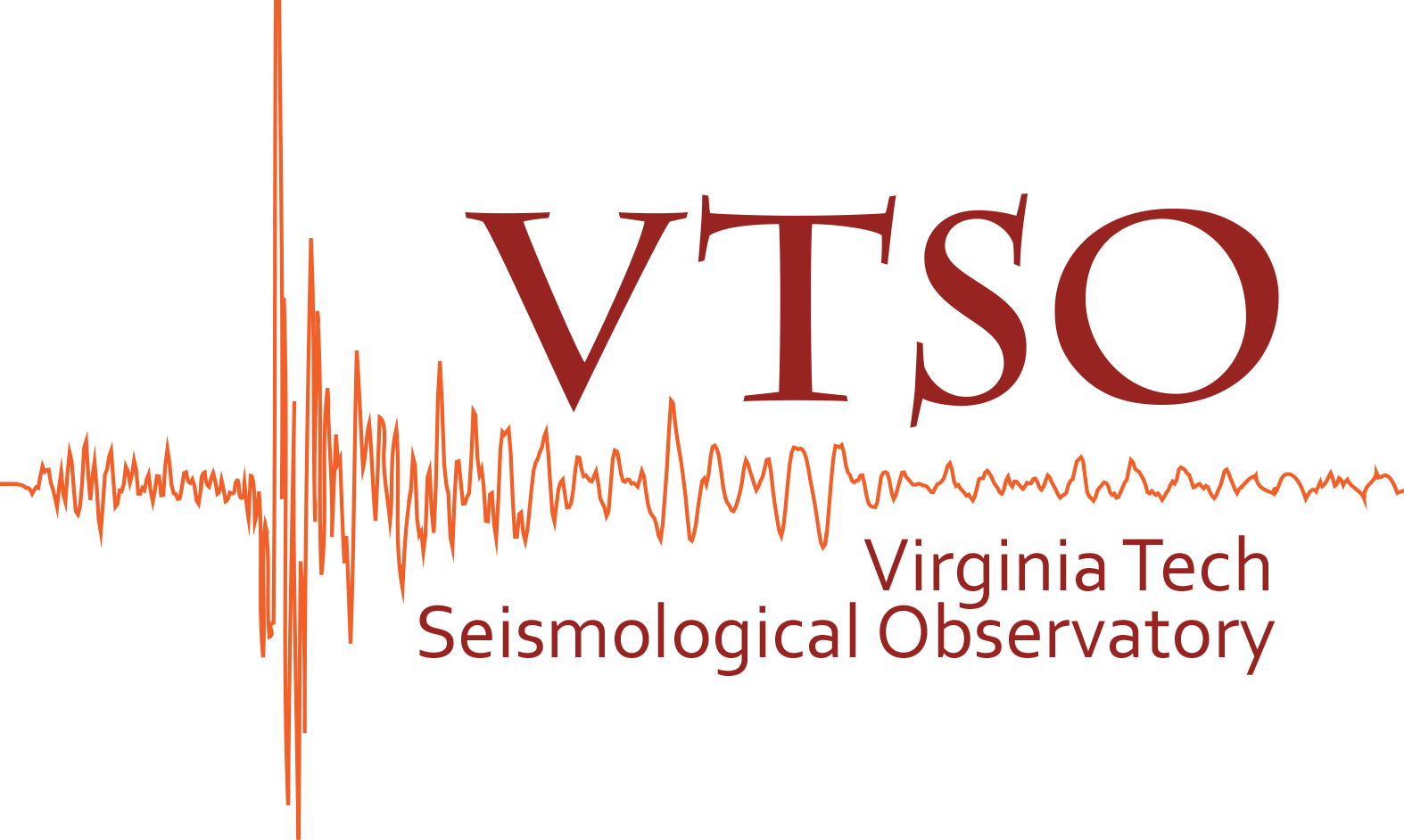The Virginia Tech Seismological Observatory
History of VTSO
In 1963, a seismic station was installed at Blacksburg under the direction of Professor C. E. Sears as part of the first world-wide network of seismic stations. In 1977 the Virginia Tech seismic network was established by Professor G.A. Bollinger. Initially, the recording was purely analog, but in 1985 digital recording was added. In 1995, a US National Seismic Network broadband, high dynamic range seismograph was installed in Blacksburg, whic is still in use today. In 1997 the Giles County network was upgraded to digital telemetry. The current network configuration is shown in the figure below.

In 1991, Virginia Tech combined with other institutions in North Carolina and Tennessee to form the Southern Appalachian Cooperative Seismic Network to coordinate earthquake monitoring and data exchange. For many years, VTSO published yearly bulletins and catalogs tracking seismic events in the Southeastern United States (S.E.U.S.), however, funding cuts in the mid-2000s brought a stop to that. With the M5.8 earthquake in central Virginia in 2011, attention was again brought to Virginia earthquakes and the potential for seismic activity in the S.E.U.S.
The VTSO is currently run by Dr. Martin Chapman.
Mission
At VTSO, we study intraplate earthquakes, specifically those in the southeastern United States, though we've also recently begun working on the problem of induced seismicty through the country. We're working to develop a broader understanding of why earthquakes occur in these active regions outside of tectonic plate boundaries and to help establish a better understanding of what the earthquake risks and hazards might be in these regions.
People of VTSO

Martin Chapman
I work in two distinct topical areas. The first is the study of seismicity and tectonics of plate interiors. The second is strong-motion seismology. My goal is to combine results from both areas and contribute an improved scientific basis for assessment and mitigation of earthquake hazards, particularly for plate-interior areas such as eastern North America. There is a strong observational element in my work. I am director of the Virginia Tech Seismological Observatory (VTSO). I study the geologic causes of the earthquakes and the characteristics of seismic wave propagation in the region using data from VTSO stations as well as other seismic stations in eastern North America. As a strong-motion seismologist, I make extensive use of the world-wide collection of strong motion data from large earthquakes to characterize and predict damaging motions in the near-fault distance range in a variety of tectonic environments.

Arthur Snoke
Arthur is an emeritus faculty researcher for VTSO.

Jake Beale
I have been a Research Associate with VTSO since 2008. I have worked on various funded projects over the years, including three main topics of study: 1) Seismic monitoring of an active coal mine in southwest Virginia; 2) Studies related to understanding the seismic activity around Summerville, SC; 3) Studies related to ongoing earthquake activity in Virginia. My areas of expertise include seismic-reflection-data processing, rudimentary earthquake seismology, programming and scripting, and GIS. I have a B.S. degree in Geology and a M.S. degree in Geophysics, both from the Department of Geosciences at Virginia Tech.

Ariel Conn
Ariel's focus is on establishing what correlations may exist between induced seismicity and wastewater disposal wells. She's developing a comprehensive catalog of earthquakes and disposal wells from around the country to determine which locations are likely experiencing induced seismicity. She is also interested in developing stronger communication between scientists, as well as between scientists and the general public. As such, all of her work can be found (hopefully easily) on VTSO. She earned a BA in English from the University of Oregon and worked in advertising and marketing before going back to school to earn a BS in physics from Idaho State University and an MS in Geosciences from Virginia Tech.

Anna Hardy
Anna's research involves monitoring the seismicity of the epicentral area of the 1886 Charleston, South Carolina earthquake. From August 2011-August 2012, a temporary seismic network was installed by Dr. Martin Chapman and Jake Beale; during that time, they detected over 100 events. Anna processed and rotated the stations' seismograms for each event. After that, she was able to pick P and S wave arrival times and measure their amplitudes. These parameters are important for determining the hypocenter locations and deriving focal mechanism solutions for the earthquakes. If the hypocenter locations and focal mechanisms solutions can be reasonably constrained, they can shed light on the fault structure of the epicentral region and the regional stress field.

Qimin Wu
I am now working on two different projects, both of which are related to the August 23 2011 Mw 5.8 Mineral, Virginia Earthquake. The first project involves event detection and location as well as focal mechanism solutions determination and stress field inversion of the aftershock sequence of the 2011 Virginia earthquake. To detect as many aftershock events as possible, I developed a program jointly using STA-LTA algorithm and cross-correlation technique to automatically scan through continuous seismic waveform data to detect earthquakes; and ~ 4000 events were found from August 25 2011 through December 31 2011, when enough stations were operating near the mainshock epicentral area. And then the single-event location using both P and S phase arrival times were conducted on over 3000 locatable events, which ended up with ~1700 well-constrained earthquake locations. Subsequent to single-event location, I applied the double-difference program HypoDD to relocate the earthquakes, and the results reveal that most aftershock are in a tabular zone with strike and dip similar to the main shock focal mechanism and shallower depth than the main shock (8 km). Also, the relocated aftershocks illuminate a new fault that was activated by the mainshock approximately 10 km to the main aftershock zone. Furthermore, focal mechanisms of 378 events were determined by using program FOCMEC. To better interpret the results, we are trying to apply a stress inversion from those obtained focal mechanism solutions. This work is still going on. Hopefully, it will help resolve the details of the mainshock faulting process and also it will enable us to better understand the connection between geological structure and seismicity in central Virginia seismic zone. The other project aims to study the near-source geometrical spreading effects from the aftershocks of 2011 Virginia earthqauke. Since I just get started with this one, the details will be provided later.
I got both my BS (2009) and MS degree (2012) in Geophysics from University of Science and Technology of China (USTC). I joined Department of Geosciences at Virginia Tech in August, 2012. And I am now in my third year working with Dr. Martin Chapman pursuing the Ph.D degree in Seismology.
Selected Publications
Chapman, M.C. and J.N. Beale (2010). On the Geologic Structure at the Epicenter of the 1886 Charleston, South Carolina Earthquake, Bulletin of the Seismological Society of America, vol. 100, no. 3 1010-1030.
Chapman, M.C., and J.N. Beale (2010). Mesozoic-Cenozoic Structure at the Epicenter of the 1886, Charleston, South Carolina, Earthquake, Seismological Research Letters , vol. 81 no. 2, 360.
Chapman, M.C. and J.N. Beale (2010). The 1886 Charleston, South Carolina Earthquake: Fault Reactivation in a Mesozoic Extensional Terrane, Joint Northeastern - Southeastern Section Annual Meeting, Geological Society of America, URL www.geosociety.org/sectdiv/northe/2010mtg/.
Chapman, M.C. and J.N. Beale (2010). Results of reprocessing seismic reflection data near Summerville, South Carolina, Seismological Research Letters , vol 81 no. 1, 154.
Chapman, M.C. (2009). A Comparison of Short-Period and Broadband Seismograph Systems in the Context of the Seismology of the Eastern United States, Seismological Research Letters, 80, 936-952.
Chapman, M.C. (2009). Broadband Receiver Functions at Stations in the Southeastern United States, Seismological Research Letters, 80, no. 1, pp 166.
Chapman, M.C. and J.N. Beale (2008). Mesozoic and Cenozoic Faulting Imaged at the Epicenter of the 1886 Charleston, South Carolina Earthquake, Bulletin of the Seismological Society of America, 98, 2533-2542.
Chapman, M.C. and S.D. King (2008). Upper Mantle Structure Beneath the Southeastern United States from Receiver Functions: Evidence for Small-Scale Mantle Convection?, Eos Trans., 89, AGU Fall Meeting, Abstract no. S43A-1878.
Chapman, M.C. and J.N. Beale, (2008). Faulting at the Epicenter of the 1886, Charleston, South Carolina Earthquake Imaged by Seismic Reflection Profiling, Eos Trans., 89, AGU Fall Meeting, Abstract no. S13-04.
Chapman, M.C. and J.N. Beale (2008). Significant faulting imaged at the epicenter of the 1886 Charleston, South Carolina Earthquake, Seismological Research Letters, 79, no. 2, 315.
Chapman, M. C. (2008). A Comparison of Co-located Short-Period and Broadband Seismograph Systems, Seismological Research Letters, 79, no. 1, 139.
Chapman, M.C., J.N. Beale and R.D. Catchings (2008). Q for P-waves in the sediments of the Virginia Coastal Plain, Bulletin of the Seismological Society of America, 98, 2022-2032.
Chapman, M.C. and J.N. Beale (2008). P Wave Attenuation in the Virginia Coastal Plain, Seismological Research Letters, 79, no. 1, 137.
Chapman, M.C. (2007). Near-source Vertical Ground Motions at Soil Sites: S to P Conversion at the Soil-rock Interface, Seismological Research Letters, 78, no. 1, 163.
Chapman, M.C., J.R. Martin, C.G. Olgun, and J.N. Beale (2006). Site-Response models for Charleston, South Carolina, and vicinity developed from shallow geotechnical investigations, Bulletin of the Seismological Society of America 96, 467-489.
Chapman, M.C. (2006). Simultaneous Vertical and Horizontal Strong Motion: Soil Sites and Reverse Faults, Seismological Research Letters, 77, no.2, 320.
Dunn, M. M. and M.C. Chapman (2006). Fault Orientation in the Eastern Tennessee Seismic Zone: A Study Using the Double-Difference Earthquake Location Algorithm, Seismological Research Letters, 77, no. 4, 494-504.
Kim, W-Y and M.C. Chapman (2005). The 9 December 2003, Central Virginia, Earthquake Sequence: A Compound Earthquake in the Central Virginia Seismic Zone, Bulletin of the Seismological Society of America, 95, 2428-2445.
Lester, A. P. and M. C. Chapman (2005). An Examination of Site Response in Columbia, South Carolina, Seismological Research Letters, 76, no.1, 118.
Dunn, M. and M. Chapman (2005). Relocation of Eastern Tennessee Earthquakes Using HypoDD, Seismological Research Letters, 76, no. 1, 115
Chapman, M. C., (2005). The Seismicity of Central Virginia, Seismological Research Letters, 76, no.1, 115.
